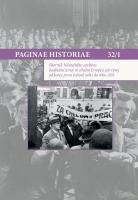Vatikán a nástup radikální levice ve střední Evropě po roce 1918
The Vatican and the Radical Left in Central Europe after 1918
Author(s): Marek ŠmídSubject(s): History, Interwar Period (1920 - 1939), History of Communism, History of Religion
Published by: Národní archiv
Keywords: Vatican; radical left; church history
Summary/Abstract: The study deals with the clash of the Holy See with the radical leftist regimes, so-called soviet or council republics, which rose to power for a short time after the First World War. There were eight soviet-governed states in Central Europe, Eastern Europe, and the Near East between 1918 and 1920; the study primarily focuses on the Hungarian Soviet Republic, Slovak Soviet Republic, and Bavarian Soviet Republic. The paper reflects that following the experience with Bolshevik Russia, the Holy See soon realised that the emergence of atheistic regimes in Central Europe brought about severe persecution of the Catholic Church. While the Holy See demonstrated considerable disdain towards the representatives of these republics, on the other hand it did not hesitate to request concessions in the interest of Catholicism or benefits for the church. The opposition of the Holy See representatives towards the regime that threatened to eliminate the current church-political arrangement solidified. They believed in its short-term existence and poor support by Central European inhabitants. Their negative experience with the left wing impacted the post-war political direction of the Catholic Church that every so often became close to the right-wing regimes, e.g. in Italy and Germany, that showed less anti-religious opposition or pragmatically hid their disdain towards the church.
Journal: Paginae Historiae
- Issue Year: 32/2024
- Issue No: 1
- Page Range: 49-61
- Page Count: 13
- Language: Czech

